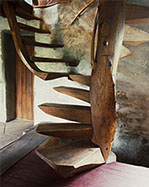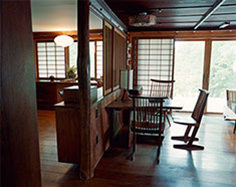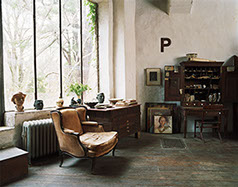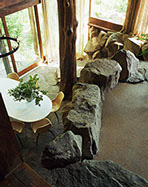THE ARTISTS AND HOMES

WHARTON ESHERICK (1887-1970) -
Impressionist painter who studied at the
Pennsylvania Academy of Fine Arts, Sculptor
and father of the current studio furniture
movement built his studio and home in Chester
County, near Philadelphia in three stages. From
1921 to 1941 and then in 1966. Wharton made
(and decorated) absolutely everything possible,
imaginatively drawing on the landscape around
him, using the local wood and stone, constructing
outbuildings, crafting furniture, carving utensils,
a testament to the artist's dramatic vision. "If you
want to know me, look at my work," he once said.
The artist died in 1970. His Heirs and hundreds
of friends have kept the studio intact: everything
is polished and dusted, the landscape is still
wooded and open to the public.
http://www.whartonesherickmuseum.org

GEORGE NAKASHIMA (1905-1990)- was a
Japanese American woodworker and one of the
leading innovators of 20th Century furniture
design and a father of the American craft
movement. Nakashima's signature woodworking
design was his large-scale tables made of large
wood slabs with smooth tops but unfinished
natural edges. He built his home and studio in
New Hope, Pennsylvania listed on the U.S.
National Register of Historic Places in August
2008. Mira Nakashima has extended the tradition
of the George Nakashima Studio by producing
the classic and traditional lines, and continuing
the "Altars of Peace" project, his dream that if
each were made for each continent of the world,
as centers for meditation, prayer and activities for
peace, the world would be a better place.
http://www.nakashimawoodworker.com

HENRY VARNUM POOR (1888-1970)- Little
heard of today, in the first half of the 20th ,
Century, was considered one of this country's
most important painters, living among a secluded
colony of writers, artists and assorted Hollywood
glitterati in upstate New York. Crow House-where
he felled his own timber and quarried his own
stone to realize a home inspired by Arts and
Crafts ideals-became the informal centre of this
American Bloomsbury. Poor's versatility and
lifelong involvement with pottery is also evident
throughout Crow House: cups and bowls are
visible on shelves, vases are set into niches and
on table tops, and ceramic plates, rather than
paintings, are hung on (and sometimes
embedded into) the walls as decoration. As
recently as last year, Crow house has been
saved from ruin, a foundation has been
established and work has begun on restoring
and preserving this treasure.
http://henryvarnumpoor.com

MANITOGA- the home of Russel Wright.
(1904-1976) The Great American designer
created a home on an abandoned quarry in
Garrison New York, that bears comparison with
the best of Frank Lloyd Wright. "Home of the
Great Spirit" may be the single superb example
of ecological design in the United States says
famous landscapist Ian McHarg. Wright opened
his land to the public a year before he died,
at the age of 72, in 1976. In 1997 Manitoga was
listed on the National Register of Historic Places.
The home is preserved and maintained by the
Russel Wright Design Center realizing Wright's
"goal to bring to American culture an intimacy
with nature".
http://www.russelwrightcenter.org